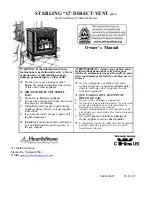
INS
TALLA
TION
Residen al Hybrid Electric Heat Pump Water Heater Use and Care Guide
•
13
INSTALLATION
3
Terminate the discharge pipe
a maximum of 12” (300mm)
above a
fl
oor drain, sump or
other safe loca on . Do not drain the
discharge pipe into the drain pan;
instead pipe it separately to an
adequate drain.
DISCHARGE
PIPE
DRAIN
PIPE
Figure 16 -
The end of the T&P Relief Valve
discharge pipe must stop no more than 12”
(300mm) above a drain .
4
Do not place any valve or
other restric on between the
tank and T&P Relief Valve. Do
not cap, block, plug, or insert any valve
between the T&P Relief Valve and the
end of the discharge pipe. Do not
insert or install any reducer in the
discharge pipe.
Step 8:
Install shuto
ff
and
mixing valves
1
If one is not already installed,
install a manual shuto
ff
valve
in the cold water line that
supplies the water heater. Install the
shuto
ff
valve near the water heater so
that it is readily accessible. Only use
valves that are compa ble with
potable water. Use only full-
fl
ow ball
or gate valves. Other types of valves
may cause excessive restric on to the
water
fl
ow.
2
Install a Thermosta c Mixing
Valve . Consult the valve
manufacturer’s instruc ons or
a quali
fi
ed person.
Figure 17 -
Install Thermostatic Mixing
Valves where required.
WARNING! Even if the water
heater’s thermostat(s) are set to a
rela vely low temperature, hot water
can scald. Install Thermosta c Mixing
Valves to reduce the risk of scalding.
3
For water heaters that are fed
by a solar water hea ng
system (or any other pre-heat-
ing system), always install a Thermo-
sta c Mixing Valve or other tempera-
ture limi ng device in the inlet water
supply line to limit water supply inlet
temperature to 140°F (60
°
C). Solar
water hea ng systems can supply water
with temperatures exceeding 170°F
( 77
°
C) and may result in water heater
malfunc on. Such a malfunc on is not
covered under the water heater
warranty.
WARNING! Hot water provided by
solar hea ng systems can cause severe
burns instantly, resul ng in severe
injury or death (
page 4
).
Step 9:
Connect the water
supply
1
Determine the type of water
pipes in your home. Most
homes use copper water
pipes or cross-linked polyethylene
(PEX) but some use CPVC. Use
fi
ngs
appropriate for the type of pipe in
your home. Do not use iron or PVC
pipe – they are not suitable for potable
water.
2
Connect the cold water supply
using 3/4in Na onal Pipe
Thread “NPT” to the blue cold
water connec on near the bo om of
the heater.
For ease of removing the water heater
for service or replacement, connect
the water pipes with a union. We
recommend using a dielectric-type
union (available at your local plumbing
supplier ). Dielectric unions can help
prevent corrosion caused by tiny elec-
tric currents common in copper water
pipes and can help extend the life of
the water heater.
Recircula ng Loop
In order to optimize efficiency of this
unit, it is not recommended for use
with a recirculation loop. Using this in
a recirculation loop may cause the unit
to run excessively.














































